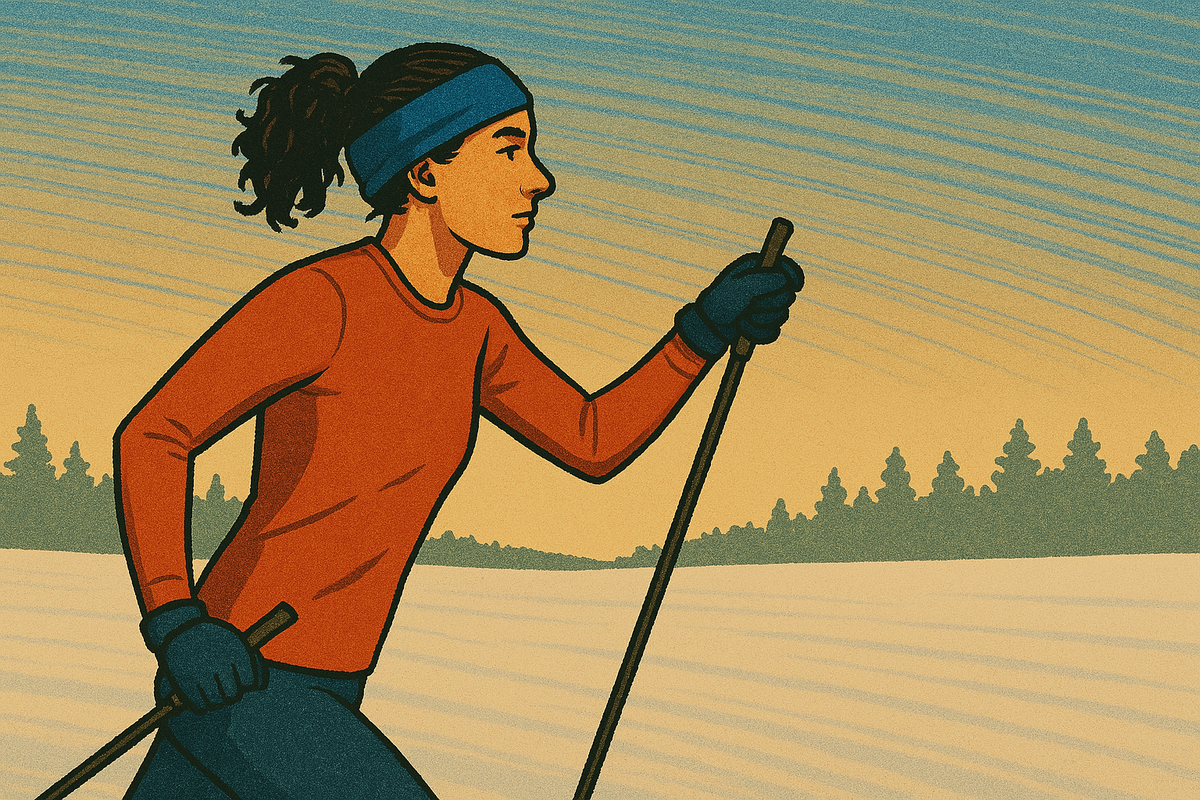
Ever wondered if your cross-country ski poles are the perfect length for you? While most skiers stick with conventional sizing (around 85-90% of body height for skating technique), new research suggests that a small adjustment could make a significant difference in your performance.
The Surprising Impact of Longer Poles
Recent research has revealed something fascinating: female cross-country skiers can improve their performance significantly by using poles that are just 7.5 cm longer than their usual choice. In fact, skiers in the study performed an average of 7.1 seconds faster over a 5-km course when using the longer poles - that’s an improvement that could mean the difference between reaching the podium or not!
But the benefits didn’t stop at speed. Skiers also reported:
- Lower perceived exertion (feeling that the effort was easier)
- Better technique and comfort
- No difference in physiological strain (same heart rate and blood lactate)
Where You’ll Notice the Difference
If you’re wondering where those time savings come from, the biggest improvements were seen in two key areas:
Starting acceleration - The first 200 meters were significantly faster with longer poles, helping skiers establish early momentum.
Uphill sections - The most substantial time savings occurred on the challenging uphill portions of the track, where efficiency matters most.
What’s particularly interesting is that these improvements came with a change in technique. With longer poles, skiers naturally used more of the G3 skating technique (where poles are planted simultaneously while skating) and less of the G2 technique (where poles are planted asymmetrically).
Why Does This Work?
Longer poles likely improve your skiing efficiency for several reasons:
- They create a better poling angle and more upright position
- They reduce unnecessary vertical movement of your body
- They allow for longer poling time and more effective force application
- They enable you to use the G3 technique more effectively and over a wider range of terrain
This makes perfect biomechanical sense. The G3 technique shares many similarities with double poling in terms of how upper body strength contributes to forward propulsion. Since longer poles have already shown benefits in double poling, it’s logical that they would enhance G3 skating technique as well.
Finding Your Optimal Pole Length
Want to try longer poles yourself? Here’s how to approach it:
Measure your current poles - Standard skating poles are typically about 89-90% of your body height (compared to 83-85% for classic technique).
Experiment gradually - Try poles that are 5-7.5 cm longer than your current ones. The study used poles that were about 94% of body height.
Give yourself time to adjust - Even the elite skiers in the study needed some adaptation time. One skier initially struggled with the timing of pole plants but then found significant benefits on uphill sections.
Pay attention to technique shifts - Notice how longer poles might naturally encourage you to use more G3 technique, especially on flats and moderate uphills.
Be patient with steep sections - A few skiers noted that very steep, short uphills (where rapid repositioning is needed) were more challenging with longer poles.
Is This Approach Right for You?
While the research showed benefits across all participants, the most significant improvements were seen in the most technically proficient skiers. This suggests that having a well-developed upper body and refined technique helps you take full advantage of longer poles.
The good news? Even if you’re not an elite skier, you can still benefit from experimenting with pole length while working on your technique and upper body strength.
The Bottom Line
Cross-country skiing equipment has evolved dramatically since the sport’s beginnings, but pole length in skating has remained relatively unchanged since the 1980s. This new research suggests it might be time to reconsider the conventional wisdom.
By trying slightly longer poles, you might discover a simple equipment change that helps you ski faster with less perceived effort—especially during those challenging uphills where every advantage counts!
This article is based on research by Per-Øyvind Torvik, Roland van den Tillaar, Guro Bostad, and Øyvind Sandbakk, published in the Journal of Science in Sport and Exercise (2021). The study examined the effect of pole length on performance and technique selection during on-snow skating in female cross-country skiers.
Discover More
- Does Swearing Make You Stronger? the Surprising Science Behind Cursing and Performance
- Power Up Your Performance With Probiotics: How Gut Health Could Be Your Secret Weapon
- Move Your Mood: How Exercise Lifts Depression and Anxiety During Menopause
- The Weekend Warrior vs. Regular Exercise: What's Best for Slowing Down Your Biological Clock?
- Can Creatine Save Your Workout When Cutting Carbs?
- Carnivore Diet for Athletes: Do You Need Carbs After All?
- Mix It Up! How to Combine Cardio and Strength Training for Maximum Results
- Rocking Your Walk: How Unstable Shoes Could Strengthen Your Feet and Improve Your Balance
- Trail Running Safety: Navigate the Path to Injury-Free Adventures
- Tech Your Way to Better Fitness: How Older Adults Are Using Digital Tools to Stay Active
- Rest Periods Matter: Finding Your Sweet Spot for High-Intensity Sprint Training
- Supercharge Your Jump: How Adding Bands to Your Deadlift Can Boost Performance
- Caffeine Before Exercise: Is Your Pre-Workout Cup of Joe Actually Helping You Burn Fat?
- Paws-Itively Perfect Exercise: How Your Dog Can Be Your Best Workout Partner
- The Long and Short of It: How Pole Length Can Boost Your Cross-Country Skiing Performance
- Time-Restricted Eating: Get Leaner Without Losing Your Gains
- Boost Your Strength & Shed Fat: Essential Amino Acids + Resistance Training
- Finding Your Perfect Fit: How Footwear Affects Performance and Injury Risk
- HIIT vs. Moderate Exercise: The Mood Rollercoaster Your Workout Takes You On
- Hydration Hype: Do Specialty Drinks Boost Exercise Performance? See more
